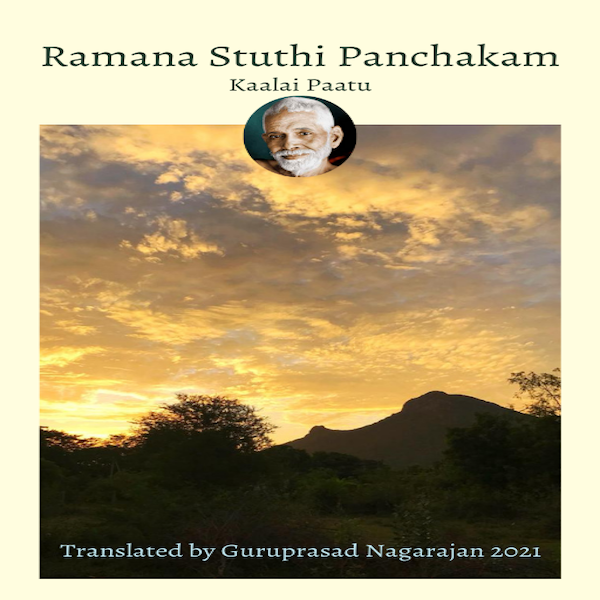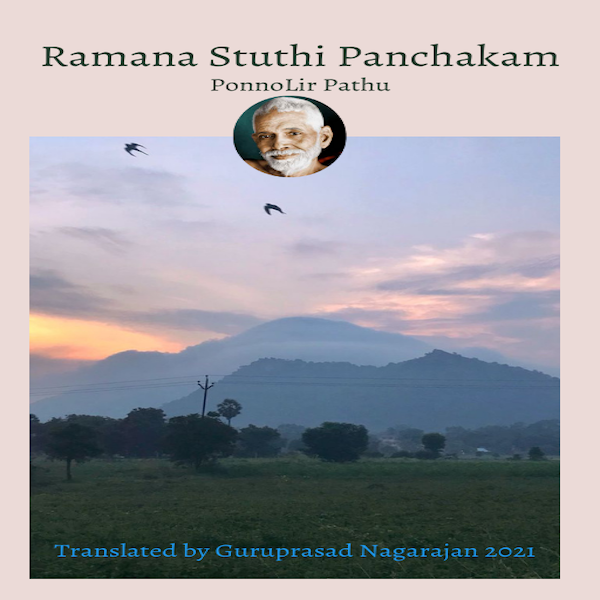Adi vedhi yan anburu vaagiyor
Jodhi mamalai soNayil vandhava
Needhi odhu ramaNa niranjana
Kaadhil odhu gadhi peru maargame
Word meaning
Adi = beginning; vedhiyan = One who knows Brahman, Vedas; anbu uru = love form; ma malai, soNai = great hill, Arunachala; needhi = justice, right and wrong; kaadhil = in the ear; odhu = say, chant; gadhi = redemption, moksha; maargam = way.
Meaning
Ramana, the foremost lord established in Brahman! You who came to the hill that is the form of light! You speak/teach us the law of atma vichara! Pure One! Please whisper in my ear the way to redeem myself!
Again SV refers Bhagavan as vedhiyan, meaning one established in Brahman, also Shiva (in Thevaram song, ‘Sotrunai vedhiyan …’ sung by Appar, Shiva is praised as the meaning of the Vedas). Since Shiva is an ancient god in Saiva sidhantha, he is also referred to as Adi Sivan, the first god.
Jodhi mamalai refers to Arunachala, the Hill of Light. It is the light that shows us the way out of samsara. Needhi has a few interpretations, the primary one being justice, it can also be taken to mean the discrimination between right and wrong, right conduct etc. SV calls Bhagavan as the one who came to impart the law of atma vichara. Odhu means read, chant but since Bhagavan rarely spoke, we can take it to mean teach.
In the next line, SV is beseeching Bhagavan to whisper in his ear the way to redemption. This act of a guru initiating a student by whispering the secret sacred mantra into the ear is an ancient Vedic tradition. It is followed when a child is initiated into the holy Gayatri mantra on the investiture of sacred thread when the father whispers the mantra into the ear of the son. Since the mantras are secret, they are whispered into the ear of the student so he can preserve and respect this highest knowledge.
Rama is the mantra that is known as the taraka mantra, meaning the mantra that helps one cross the ocean of samsara, to attain ‘gadhi’ or ‘gati’ this two syllable mantra has been cherished and glorified for generations.
It is said that when the time comes for a soul to depart (when the dying person is in Benares) Lord Siva whispers in the ears of the person the name of Rama which is guaranteed to grant moksha. [It is said that to be born in Tiruvarur, to have darshan at Chidambaram, to die in Kashi will guarantee moksha, while the mere remembrance of Arunchala bestows liberation.]
Sri Bhagavan on many occasions clarified on the benefit of Nama japa, and in particular, about Rama Nama.
(From Yogi Ramaiah)
Q. What is meant by Rama?
A. That in which everything takes its origin, exists and disappears is Rama.
“Sri Rama is Dakshinamurti, and Dakshinamurti is Sri Rama. Do you know where Ayodhya is? The Vedas say it is in the Sun, and describe it as ashtachakra navadwara devanam Purayodhya (the Gods’ city is Ayodhya with eight corners and nine gates). Arunachala is also astachakra puri (eight-cornered city), and Lord Arunachala is Sri Rama as well as Dakshinamurti. One has no need to go to the Sun to see Ayodhya or Sri Rama, but one may see them here and now.”
Talk 78.
DEVOTEE: How to find the Atman?
Mantra japa leads to elimination of other thoughts and to concentration on the mantra. The mantra finally merges into the Self and shines forth as the Self.
In another talk:
Japa even once uttered has its own good effect, whether the individual is aware or not.
While Bhagavan never gave upadesa to anyone (except ‘pokkiri’ Mani who was adamant that he be given a mantra, Bhagavan said, ‘’Say Siva,Siva and be quiet/still’), SV seeks an upadesa like a disciple would from the master.
Jodhi mamalai soNayil vandhava
Needhi odhu ramaNa niranjana
Kaadhil odhu gadhi peru maargame
Word meaning
Adi = beginning; vedhiyan = One who knows Brahman, Vedas; anbu uru = love form; ma malai, soNai = great hill, Arunachala; needhi = justice, right and wrong; kaadhil = in the ear; odhu = say, chant; gadhi = redemption, moksha; maargam = way.
Meaning
Ramana, the foremost lord established in Brahman! You who came to the hill that is the form of light! You speak/teach us the law of atma vichara! Pure One! Please whisper in my ear the way to redeem myself!
Again SV refers Bhagavan as vedhiyan, meaning one established in Brahman, also Shiva (in Thevaram song, ‘Sotrunai vedhiyan …’ sung by Appar, Shiva is praised as the meaning of the Vedas). Since Shiva is an ancient god in Saiva sidhantha, he is also referred to as Adi Sivan, the first god.
Jodhi mamalai refers to Arunachala, the Hill of Light. It is the light that shows us the way out of samsara. Needhi has a few interpretations, the primary one being justice, it can also be taken to mean the discrimination between right and wrong, right conduct etc. SV calls Bhagavan as the one who came to impart the law of atma vichara. Odhu means read, chant but since Bhagavan rarely spoke, we can take it to mean teach.
In the next line, SV is beseeching Bhagavan to whisper in his ear the way to redemption. This act of a guru initiating a student by whispering the secret sacred mantra into the ear is an ancient Vedic tradition. It is followed when a child is initiated into the holy Gayatri mantra on the investiture of sacred thread when the father whispers the mantra into the ear of the son. Since the mantras are secret, they are whispered into the ear of the student so he can preserve and respect this highest knowledge.
Rama is the mantra that is known as the taraka mantra, meaning the mantra that helps one cross the ocean of samsara, to attain ‘gadhi’ or ‘gati’ this two syllable mantra has been cherished and glorified for generations.
It is said that when the time comes for a soul to depart (when the dying person is in Benares) Lord Siva whispers in the ears of the person the name of Rama which is guaranteed to grant moksha. [It is said that to be born in Tiruvarur, to have darshan at Chidambaram, to die in Kashi will guarantee moksha, while the mere remembrance of Arunchala bestows liberation.]
Sri Bhagavan on many occasions clarified on the benefit of Nama japa, and in particular, about Rama Nama.
(From Yogi Ramaiah)
Q. What is meant by Rama?
A. That in which everything takes its origin, exists and disappears is Rama.
“Sri Rama is Dakshinamurti, and Dakshinamurti is Sri Rama. Do you know where Ayodhya is? The Vedas say it is in the Sun, and describe it as ashtachakra navadwara devanam Purayodhya (the Gods’ city is Ayodhya with eight corners and nine gates). Arunachala is also astachakra puri (eight-cornered city), and Lord Arunachala is Sri Rama as well as Dakshinamurti. One has no need to go to the Sun to see Ayodhya or Sri Rama, but one may see them here and now.”
Talk 78.
DEVOTEE: How to find the Atman?
Mantra japa leads to elimination of other thoughts and to concentration on the mantra. The mantra finally merges into the Self and shines forth as the Self.
In another talk:
Japa even once uttered has its own good effect, whether the individual is aware or not.
While Bhagavan never gave upadesa to anyone (except ‘pokkiri’ Mani who was adamant that he be given a mantra, Bhagavan said, ‘’Say Siva,Siva and be quiet/still’), SV seeks an upadesa like a disciple would from the master.







 RSS Feed
RSS Feed